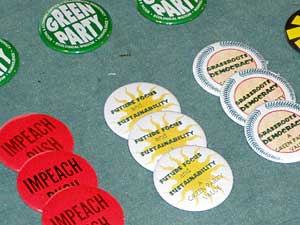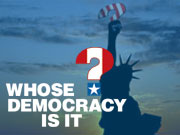|
Audio
Photos
Your Voice
|
The rise and fall of third parties
November 3, 2003
 |
| The Independence and the Green Parties enjoy fairly liberal ballot access and campaign finance laws in Minnesota. Both are considered "major parties" and are therefore guaranteed a spot on state ballots and access to public campaign finance subsidies. (MPR Photo/MIchael Khoo) |
St. Paul, Minn. — In Minnesota, late summer means the annual State Fair. And the State Fair means retail politics. Here, that's not just Democrats and Republicans. Near the grandstand, next to the fried cheese curd booth, that's the Independence Party; former Gov. Jesse Ventura's team. Go on up to the grandstand's second level, over on the right: It's Diane Peterson's shift at the Green Party table.
"I'm a hard-core environmentalist. And I'm also active as a citizen volunteer activist in social justice issues, in addition to environmental justice issues. And it's the Green Party that really puts their money where their mouth is," Peterson says.
 | |||
For Peterson and others in Minnesota and across the country, the traditional two parties have lost considerable luster. Depending on who you talk to, they've moved to the center, compromising their core principles. Or they've done just the opposite, abandoning the center for the extreme right and left.
Regardless of the perspective, Jim Moore thinks they've left thousands of disaffected voters behind. Moore is the chair of Minnesota's Independence Party. Sitting in the back of the IP booth, Moore envisions a new breed of moderate voters he hopes to woo.
"The people we represent are individual thinkers. They're looking for candidates who tell the truth, who focus on reality, and don't pander. And as such, this is a group that is not going to be pigeonholed into being a party member, so to speak, unless they see a full, broad spectrum that they can really jump on and ride the wave with," according to Moore.
Fair-goer Charles Switzer of St. Paul stops by the booth to fill out an opinion survey. He says plenty of his friends and family are hungry for something other than the Democrats and Republicans.
"Middle-of-the-road, down-the-center; whatever you want to call it, that's where I find myself these days. They're not tax-and-spend; they're not redistribution of the wealth to the rich. They're down the middle," says Switzer.
|
Reforms that were passed in the wake of the Watergate scandal turned out to have an unexpected effect on lifting some of the structural barriers that third political parties face.
- Lisa Disch |
The United States hasn't elected a third-party president since Abraham Lincoln's Republicans displaced the Whigs in 1860. But state and local politics are a different story. In 1990, Republican-turned-independent Lowell Weicker won the governor's office in Connecticut.
In 1994, another independent, Angus King, became governor of Maine. And four years later, former pro-wrestler Jesse Ventura made international headlines, coming out on top in Minnesota's gubernatorial contest.
Ventura was a political outsider with celebrity name recognition. But he was more than that. He was the standard-bearer for the fledgling Independence Party of Minnesota, a movement that supporters hoped would benefit from and ultimately outlive his term.
The Independence and the Green Parties enjoy fairly liberal ballot access and campaign finance laws in Minnesota. Both are considered "major parties" and are therefore guaranteed a spot on state ballots and access to public campaign finance subsidies. Both benefit from same-day voter registration policies that encourage newcomers to participate.
University of Minnesota political scientist Lisa Disch says there's no reason why similar laws in other states wouldn't produce similar movements.
"It's misunderstood to think that it has something to do with our culture or that we're kind of wacky and experimental. What happened was that reforms that were passed in the wake of the Watergate scandal turned out to have an unexpected effect on lifting some of the structural barriers that third political parties face," she says.
 | |||
But third-parties beware! Success can be fatal.
Minnesota's new Republican governor, along with Republicans and Democrats in the state Legislature, attempted to roll back provisions that help new parties find funding and secure a spot on the ballot. Disch says the established parties have no incentive to let new players on the stage.
"It should be noted that as the Legislature has learned from the example of our third parties' successes that these laws had these unintended consequences, they're starting to modify some of the laws."
It ain't easy being Green. Or Independent, Libertarian, or Socialist Worker. Setting aside the struggle against the Democrats and Republicans, voters these days seem less inclined to join a party and stick with it.
Back in the grandstand, Green Party members are making a pitch to Jeanne Kaiser of St. Paul. They've got a city council and a school board candidate in this year's election. Kaiser takes the brochures, but she makes no promises.
"I don't vote for the party; I vote for the individual. If they have the same beliefs in me," she says.
Her sister, Colleen, is even more skeptical. Although the state of Minnesota may consider the Greens a major party, Colleen Kaiser says voters want to be on the winning side; and that means making peace with the Republicans or the Democrats.
"You're going to pick the lesser of two evils. You're not going to pick the candidate that you really want to win because it's not major enough. You can call it a major party, but that's just on paper. It's not a major party," according to Kaiser.
Kaiser's argument is similar to one made by many Democrats, who say Ralph Nader's Green Party candidacy siphoned votes from Al Gore, tossing the 2000 presidential election to George W. Bush. Greens tend to reject that analysis, saying the Democrats lost because they failed to connect with their traditional supporters. In any case, they argue that the measure of the Green Party is not its record in national elections.
Joel Sipress, an organizer for the Duluth Area Green Party in Duluth, Minn., says building a successful party requires winning at the local level.
"Sometimes a race for a more high-profile office can help in that party-building process, but really, over time, the way you're going to build a new party from the bottom up is to do it methodically over the course of a number of years through grassroots, bottom-up party-building."
By that standard, Greens can count nearly 200 elected officials in 26 states. Most serve on city councils or other local boards and authorities. Minnesota has eight, including one in Duluth. But that doesn't seem to worry the traditional parties.
Ron Eibensteiner, the state chair of the Minnesota GOP, says the United States' winner-take-all system demands majority victories. He says that means any third-party that grows too large will be cannabalized by its bigger rivals.
"It's incumbent upon one of the other two parties to co-opt their message or to bring that message into the party so that they get to 50 percent of the vote," Eibensteiner says.
It happened in 1944 when the Democratic Party absorbed the Farmer-Labor Party in Minnesota. It happened in 1972 when Richard Nixon plundered George Wallace's southern base. And perhaps it's not as bad as it sounds.
Former Democratic Congressman Tim Penny once represented Minnesota's southeastern corner. Last year, he jumped over to the Independence Party to run for governor. He finished with 16 percent of the vote; dismal by Democratic or Republican standards, not bad for a third party.
Penny says he's still convinced a viable third way is possible -- even in demand. But he's also not naive.
"It'd be nice to have third choice around, a third party that lodges itself sensibly in the center. But even if it doesn't happen, the availability of that third choice, the votes that that candidate secures, and the way that that alternative influences policy-making, influences elections is still an important thing and very much central to the vibrancy of democracy," Penny says.
But first the message has to reach the voter. And for that, there is always another election and another state fair.
|
News Headlines
|
Related Subjects
|

